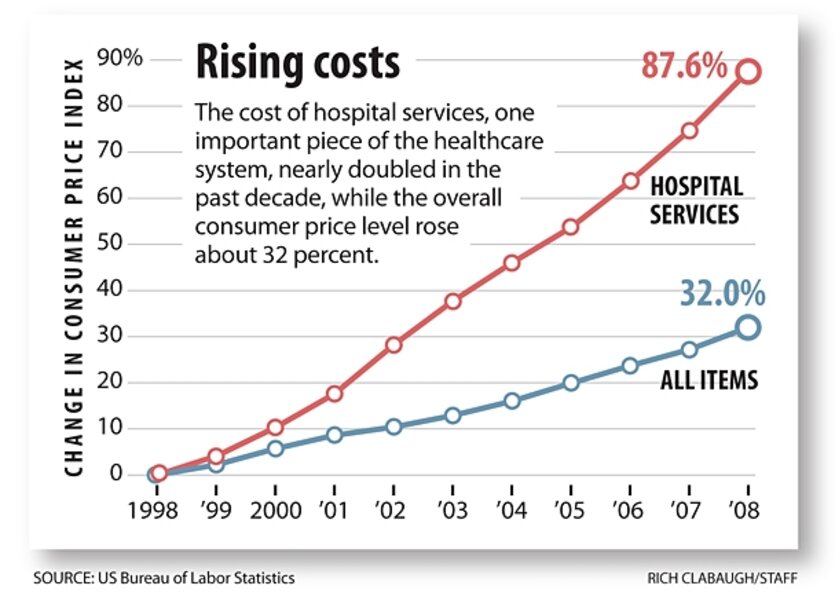Obama's push for health reform: What are the hurdles?
Loading...
President Obama’s pursuit of a healthcare overhaul, which intensifies Wednesday night with his address to Congress and the nation, has put sharper focus on a central and perplexing issue: how to control fast-rising costs. The politically easiest path is probably to put off the day of reckoning on costs, but Mr. Obama and fellow Democrats face risks if they push for expanded access to healthcare while failing to address the spending spiral.
This report surveys the choices ahead on a problem that’s thorny but not insurmountable.
Q: Why did the push for healthcare reform run into obstacles? Is cost the key issue?
A: Underlying the debate are substantive issues, and cost is one of the biggest. Obama’s push comes even as Americans are on edge financially – with workers eyeing a weak job market and taxpayers fretting about rising federal deficits, which are already at a record level due to economic stimulus measures and bank bailouts.
Against that backdrop, the nonpartisan Congressional Budget Office said early this summer that one Democratic health-reform package would probably add about $1 trillion in government spending over the next decade. The message: There’s no free lunch. Indeed, reducing the number of uninsured Americans will add costs to a system that’s already the world’s most expensive per person.
This doesn’t mean that a healthcare bill can’t pass Congress. About 45 million Americans don’t have health insurance, and millions who do are still worried that it’s only as secure as their jobs. Americans want major reforms involving access to care – but they also want fixes for those obvious issues of cost and affordability.
Q: How big is the problem of rising medical costs, if there's no cost-cutting reform?
A: It’s so large that many economists see a fiscal crisis ahead for the federal government. Much of the burden also falls on states and employers and directly on families.
Medical expenditures in the United States make up almost one-fifth of gross domestic product, and they grew faster than inflation by about 3.6 percentage points a year during the decade that ended in 2005, according to the Organization for Economic Cooperation and Development in Paris. There’s no sign the increases will end without multiple and major reforms.
Yet something has to give. Government spending can’t outrun the government's current income (tax revenues) in the huge way that’s implied by current policies.
Medical spending is rising partly because of new treatments that, health researchers say, provide considerable benefits. Granted, high costs are not unique to the US. But America’s system covers a smaller percentage of the population than in other advanced nations and often delivers poorer results.
Medicare costs are up partly because of a growing prevalence of health problems (such as obesity), as well as expanding treatments, Boston University economist Laurence Kotlikoff says in his book “The Healthcare Fix.”
Q: The healthcare industry isn’t exactly a free marketplace. Is that part of the problem?
A: Insufficient competition is a major problem, many economists say. This is a business in which the consumer generally doesn’t see the full cost of care, and those providing healthcare services don’t have to compete for consumers the way most retail stores do.
Still, how much to emphasize competition as a solution is a matter of debate. Some health-policy experts, citing other nations, emphasize the role that government can play in bargaining on behalf of consumers and holding costs down. At a minimum, they say, individuals would have a hard time finding affordable care – or making wise choices amid the complexities of insurance – without government playing a role.
“We need to think about how to heighten competition in the private sector,” says Leemore Dafny, a health-policy expert at Northwestern University in Evanston, Ill. This could mean placing more responsibility with consumers, but it also could mean making it easier for new firms to enter the market as care providers.
Often, local healthcare markets are dominated by just a couple of large insurance firms, and Professor Dafny’s recent research finds that insurers often charge higher prices to businesses with deep pockets than to less-profitable firms. “The fact that they can do that means that the market is far from perfectly competitive,” she says.
Q: What can be done to curb costs?
A: There’s no one easy fix.
Because so many Americans are uninsured, many plans seek to expand coverage while containing costs.
Some economists say the US could best do this by making the federal government the single payer for care. Whether they’re right or not, this approach lacks political momentum.
Leading legislative proposals involve helping individuals and small firms shop for insurance as part of larger “risk pools,” so they can enjoy the same pricing leverage as employees of large firms. This would be done through a government-regulated “exchange” in which insurers offer competing coverage plans. Federal subsidies would pick up a chunk of the tab for many people.
Other potential steps could include:
•Reforming Medicare’s costly “fee for service” system of payments.
•Investing in better information systems to streamline records, testing, and care.
•Having employers or government provide vouchers to families for purchasing insurance, with the goal of both expanding coverage and increasing cost-conscious choices by consumers.
•Incentivizing healthy behaviors that, for example, reduce smoking and obesity.
Those are just a few among a host of ideas, large and small in scope. Some mix of the ideas could address the problem over time.
----
Follow us on Twitter.






